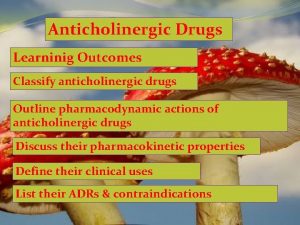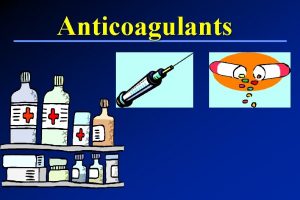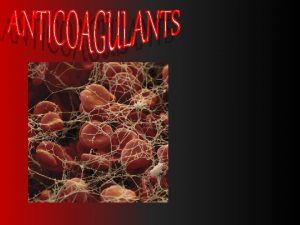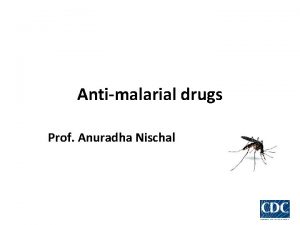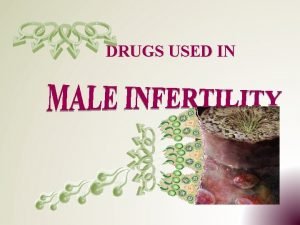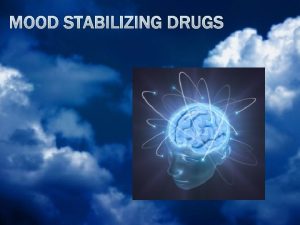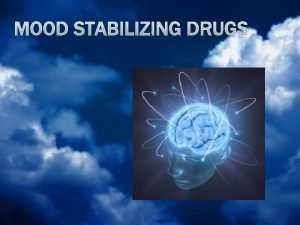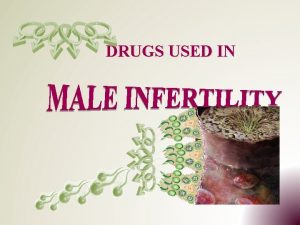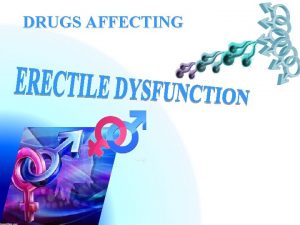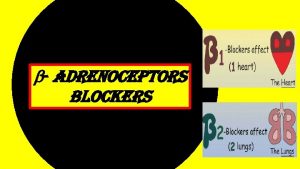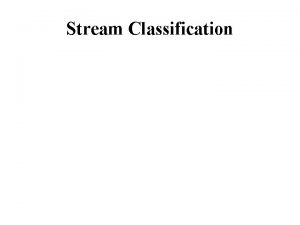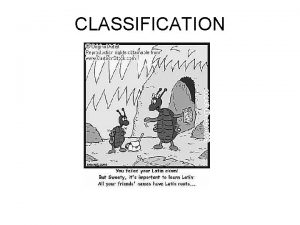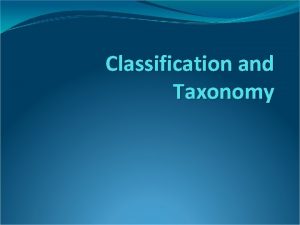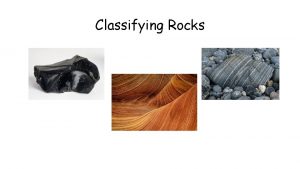Antimalarial drugs ilos Classify the main antimalarial drugs






























- Slides: 30

Antimalarial drugs ilos Classify the main antimalarial drugs depending on their goal of therapy Detail the pharmacokinetics & dynamics of main drugs used to treat attack or prevent relapses State the WHO therapeutic strategy for treatment Hint on the CDC recomendations for prophylaxis in travelers to endemic areas

Causal& Radical Clinical Supressive Cycle Sporozoitocides Gametocides prophylaxis cure prophylaxis Drugs site of action

Antimalarial drugs Therapeutic classification Causal prophylaxis Destroys parasite in liver cells & prevent invasion of erythrocytes Primaquine Supressive prophylaxis Suppresses the erythrocytic phase & thus attack of malaria fever Chloroquine, mefloquine, doxycycline

Antimalarial drugs Therapeutic classification Radical Clinical cure (erythrocytic schizonicide) Used to terminate Eradicate all an episode of forms of vivax malarial from the fever body Suppressive drug + hypnozoitocidal Fast acting Gametocidal high efficacy Destroys gametocytes & prevent transmission Chloroquine, quinine, against quinine mefloquine, vivax artemisinin Primaquine, all species Pyrimethamine, Slow acting low efficacy Sprozoitocides Destroys sporozoites proguanil, Proguanil, sulfonamides pyrimethamine

artemesinin Artemisinin is the active principle of the plant Artemisia annua(qinghaosu) Fast acting blood Schizontocide Affect all forms including multidrug resistant P. falciparum Short duration of action High recrudescence rate Poorly soluble in water & oil, can only be used orally

pharmaokinetics Rapidly biotransformed in liver into dihydroartesiminin� active metabolite Artemisinin , artesunate, artemether are prodrugs Derivatives are rapidly absorbed orally Widely distributed t½ artemisinin � 4 hrs / artesunate � 45 min / artemether 4 -11 hrs Artesunate (water-soluble; oral, IV, IM, rectal administration) Artemether (lipid-soluble; oral, IM, and rectal administration) Dihydroartemisinin (water-soluble; oral administration)

artemesinin mechanism They have endoperoxide bridges that are cleaved by haem iron to yield carboncentered free radicals, that will� Alkylate membranes of parasite’s food vacuole and mitochondria�no energy Irreversibly bind & inhibit sarcoendoplasmic reticulum Ca 2+-ATPase of the parasite, thereby inhibiting its growth Inhibiting formation of transport vesicles � no food vacuoles

artemesinin adrs Transient heart block Neutrophil count Brief episodes of fever Resistance �was reported recently in Cambodia. Thailand border

artemesinin Clinical uses Because artemisinin derivatives have short t½ , (1) monotherapy should be extended beyond disappearance of parasite to prevent recrudescence or (2) by combining the drug with long- acting antimalarial drug preparations Artesunate IV or IM preparations for severe complicated cases as cerebral malaria (24 h) followed by complete course of ACT

artemesinin preparations Artemisin-based combination therapies (ACTs): ØArtemether + lumefantrine ØArtemether + amodiaquine ØArtemether + mefloquine ØArtemether + sulfadoxinepyrimethamine

Antimalarial drugs chloroquine Potent blood Schizontocide Active against all forms of the schizonts (exception is chloroquine-resistant P. f. & P. v. ) No activity against tissue shizonts Gametoside Against all species except

chloroquine pharmacokinetics Rapidly & completely absorbed from the GIT Has high volume of distribution(1001000 l/kg) Concentrated into parasitized RBCs Released slowly from tissues Metabolized in the liver Excreted in the urine 70% unchanged Initial t½ =2 -3 days & terminal t ½=1 -

chloroquine Mechanism of action Malaria Parasite digest host cell’s Hb to obtain amino acids Heme is released � Toxic So parasite detoxifies it by heme polymerase � Hemozoin (Non. Toxic) &

chloroquine adrs 1. Mild headache and visual disturbances 2. Gastro-intestinal upsets; Nausea, vomiting 3. Pruritus, urticaria. Prolonged therapy Ocular toxicity: Loss of accommodation, lenticular opacity, retinopathy Weight loss Ototoxicity Bolus injection hypotension & Safe in pregnancy

chloroquine resistance Resistance against the drug develops as a result of mutation of the chloroquine resistance transporter (Pf. CRT) Pf. CRT enhances the efflux of chloroquine from the food vacuole

chloroquin Therapeutic uses Used to eradicate blood schizonts of. Plasmodium Hepatic amoebiasis Rheumatoid arthritis

QUININE The main alkaloid in cinchona bark Potent blood Schizontocide of all malarial parasites & weak gametoside for vivax & ovale Depresses the myocardium, reduce excitability & conductivity Mild analgesic, antipyretic, stimulation of uterine smooth muscle, curaremimetic effect

QUININE pharmacokinetics Rapidly & completely absorbed from the GIT Peaks after 1 -3 hrs 5% excreted in the urine unchanged t½ = 10 hrs but longer in sever falciparum infection(18 hrs) Metabolized in the liver & excreted in urine Administered: orally in a 7 day course or by slow IV for severe P. falciparum infection

quinine mechanism Same as chloroquine Mechanism of resistance Like chloroquine by mutation of chloroquine resistance transporter

quinine adrs With therapeutic dose �poor compliance �bitter taste. Higher doses � Cinchonism �(tinnitus, deafness, headaches, nausea & visual disturbances) Hypotension & Abdominal pain & diarrhea arrhythmias Rashes, fever, hypersensitivity reactions Blood dyscarasis; anaemia, thrombocytopenic purpura & hypoprothrombinaemia Blackwater fever, a fatal condition in which acute haemolytic anaemia is associated with renal failure and IV �neurotoxicity �tremor of the lips limbs, delirium, fits, stimulation Safe in pregnancy

quinine contraindications Prolonged QT Interval Glucose-6 -Phosphate Dehydrogenase Deficiency Myasthenia Gravis Hypersensitivity Optic Neuritis, auditory problems Dose should be reduced in renal insufficiency

quinine Clinical uses Parenteral treatment of severe falciparum malaria Oral treatment of falciparum malaria

quinine Drug interactions Antacids: Antacids containing aluminum &/or magnesium may delay or decrease absorption of quinine Mefloquine Quinine can raise plasma levels of warfarin and digoxin

primaquine Hypnozoitocides �against liver hypnozoites & gametocytocides Radical cure of P. ovale & P. vivax Prevent spread of all forms pharmacokinetics Well absorbed orally Rapidly metabolized to etaquine & tafenoquine �more active t½ � 3 -6 h

primaquine mechanism Not well understood. It may be acting by: Generating ROS �can damage lipids, proteins & nucleic acids Interfering with the electron transport in the parasite �no energy Inhibiting formation of transport vesicles � no food vacuoles Resistance; �Rare when primaquine & chloroquine are combined

primaquine adrs At regular doses �patients with G-6 PD deficiency �hemolytic anemia. At larger doses � Epigastric distress & abdominal cramps. Mild anemia, cyanosis & methemoglobinemia Severe methemoglobinemia �rarely in patients with deficiency of NADH methemoglobin reductase. Granulocytopenia & agranulocytosis � G 6 P D GSH Maintains integrity of RBCs Oxidized primaqune attacks RBCs →Hemolysi

Antimalarial drugs primaquine Clinical uses Radical cure of relapsing malaria, 15 mg/day for 14 days In falciparum malaria: a single dose (45 mg) to kill gametes & cut down transmission Should be avoided in pregnancy & G 6 PD deficiency

Who treatment guidelines falicparum In vivax uncomplicated resistant complicated sensitive All show Resistance Chloroquine for 3 days followed by ACT Primaquine for 14 days ACT / 3 days followed by IV Artesunate for 24 hrs followed by Primaquine for 14 days ACT Or Artemether + [Clindamycin / doxycyline] Or Quinine + [Clindamycin / doxycyline

Who treatment guidelines In falicparum Special risk groups Pregnancy; 1 st trimester Quinine + Clindamycin (7 days) Pregnancy; 2 nd & 3 rd trimester Lactating women Infants & young children ACT

Prophylaxis in travellers Cdc recomendations Chloroquine Areas without resistant P falciparum Mefloquine Areas with chloroquineresistant P falciparum Doxycycline Areas with multidrug-resistant P falciparum Begin 1 -2 weeks before departure (except for doxycycline 2 days) & continue for 4 weeks after leaving the endemic area
 Classify anticholinergic drugs
Classify anticholinergic drugs Will future
Will future A.1 determine the main idea of a passage
A.1 determine the main idea of a passage Void main int main
Void main int main Chó sói
Chó sói Thiếu nhi thế giới liên hoan
Thiếu nhi thế giới liên hoan Tia chieu sa te
Tia chieu sa te điện thế nghỉ
điện thế nghỉ Một số thể thơ truyền thống
Một số thể thơ truyền thống Thế nào là hệ số cao nhất
Thế nào là hệ số cao nhất Trời xanh đây là của chúng ta thể thơ
Trời xanh đây là của chúng ta thể thơ Slidetodoc
Slidetodoc Hệ hô hấp
Hệ hô hấp Thế nào là số nguyên tố
Thế nào là số nguyên tố đặc điểm cơ thể của người tối cổ
đặc điểm cơ thể của người tối cổ Các châu lục và đại dương trên thế giới
Các châu lục và đại dương trên thế giới Glasgow thang điểm
Glasgow thang điểm ưu thế lai là gì
ưu thế lai là gì Tư thế ngồi viết
Tư thế ngồi viết Cái miệng nó xinh thế chỉ nói điều hay thôi
Cái miệng nó xinh thế chỉ nói điều hay thôi Các châu lục và đại dương trên thế giới
Các châu lục và đại dương trên thế giới Cách giải mật thư tọa độ
Cách giải mật thư tọa độ Bổ thể
Bổ thể Từ ngữ thể hiện lòng nhân hậu
Từ ngữ thể hiện lòng nhân hậu Tư thế ngồi viết
Tư thế ngồi viết V. c c
V. c c Thẻ vin
Thẻ vin Thể thơ truyền thống
Thể thơ truyền thống Chúa yêu trần thế
Chúa yêu trần thế Sự nuôi và dạy con của hổ
Sự nuôi và dạy con của hổ Diễn thế sinh thái là
Diễn thế sinh thái là
